A Review of a One-Day Instructional Photo Tour (IPT) led by Arthur Morris
Please be sure to click on the images for larger, sharper presentations.
All images: © Copyright Sean T Noonan, 2000 - 2003. All Rights Reserved. No cropping or retouching done unless otherwise noted.
I attended Arthur Morrisí IPT in Queens, NY at the Jamaica Bay Wildlife Refuge (JBWR) on August 26. To save those who donít wish to read the long review that follows, I can summarize it in one sentence. It was the most fun Iíve ever had with my camera. Period. For those that want more details, please read on.
 Getting There
Getting There
On Friday, August 25, I drove down to NYC via Route 95 from Boston. 95 takes you all the way to the Bronx where you can catch the Whitestone Expressway which turns into the Van Wycke Expressway, which takes you to the Beltway. (Yes, there are other ways to get to this point). You then take the Cross Bay Boulevard South for about 2 Ĺ miles, and the entrance to the parking lot for the JBWR is on the right, at a set of lights.
Scouting The Refuge
I scouted the area on Friday night when I arrived. The Refuge is basically split into two major sections, the West Pond and the East Pond on either side of Cross Bay Blvd., with a few other small sections that werenít very interesting for photography or bird watching.
I started out from the Refuge Headquarters and followed the dirt path behind the HQ left to the West Pond trail. The trail is well maintained, and at the time, no one else was on it. Not far from the start of the trail is a clearing on the left where you can view an Osprey pole, complete with nest and a single young bird. In the mud flats surrounding the pole there were also 2 Glossy Ibis, and a half dozen Great and Snowy Egrets foraging for food. I continued down the trail and heard and spotted Catbirds, Crows and Mocking Birds. Upon arriving at the Pond proper, I was startled to see the number of birds wading, foraging in and roosting around the Pond. Very conservative counts from the West Pond on Friday include: 3 Black Skimmer, 2 Cedar Waxwing, 13 Glossy Ibis, 150+ Laughing Gull, 4 Great Blue Heron, 9 Yellow Crowned Night Heron (including 5 immature birds), 400+ Blue Winged Teal, 1500+ Common Tern, 100+ Forsterís Tern, 500+ Double Crested Cormorant, 30 Snowy Egret, 20 Great Egret, 5 Black Crowned Night Heron, 400+ Semi Palmated Plover, 200+ Semi Palmated Sandpiper, 3 Lesser Yellow Legs, 6 Short Billed Dowitchers, Tree Swallows. Lots and lots of birds!
For the bird watcher, this is the best place to visit; lots of species and high concentrations. For the photographer, however, it really isnít. The birds stick to the shores of the pond and trees around it, and as a human you are restricted to the gravel path surrounding the pond, and even with my 500mm + 1.4 TC, the majority or the birds are too far away to make any good portraits of single birds. There are two interesting shots, IMHO, however. The first is at the southernmost end of the pond, closest to the bay. Here the sun sets directly behind you (when you are looking at the pond), and a large rookery of Great and Snowy Egrets and the Black and Yellow Crowned Night Herons roost. This is an impressive site to see with such a great number of these large birds in the trees. The second is closest to the north end of the pond where with a wide-angle lens you can capture the pond (to show the concentration of birds) and the Manhattan skyline off in the distance (with sunset if you time it right).
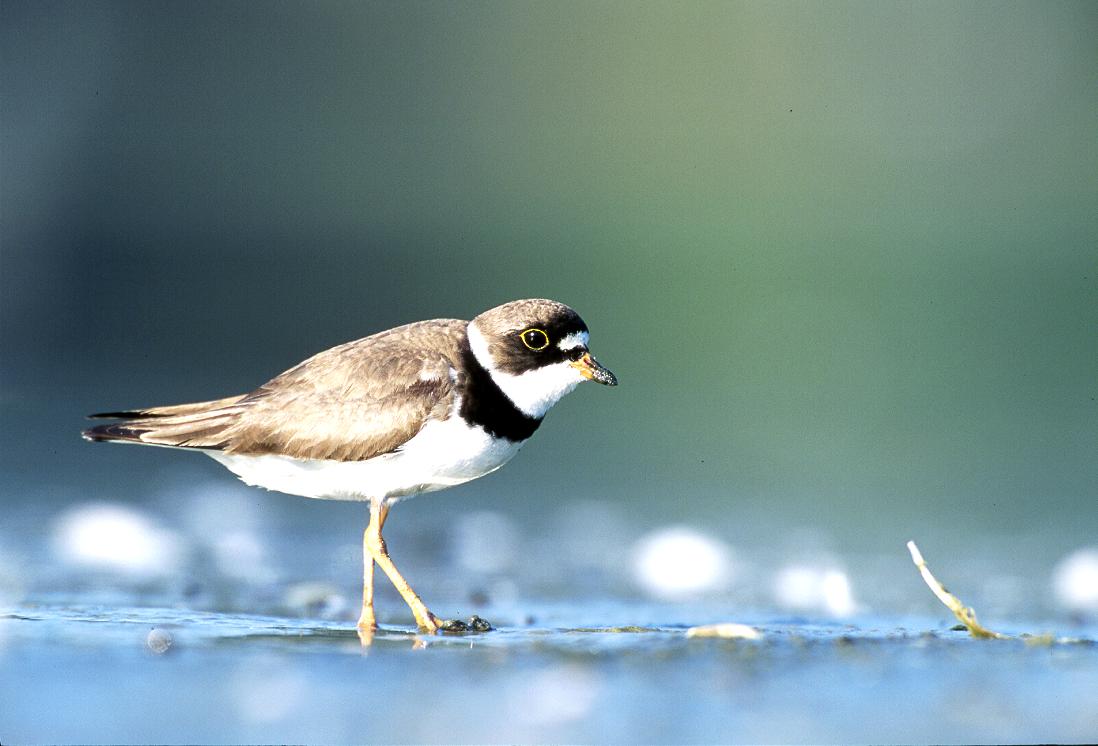 I left the West Pond and crossed the street to the East Pond. (Side note: make sure you use the crossing lights if you are going to visit the East Pond as the locals like to use the Cross Bay Blvd as a drag strip!)
I went down the Big Johnís trail and at the last bend before the pond, I was greeted by a Peregrine Falcon not 20 feet above me in a dead tree. This is the best look Iíve had at a Peregrine in the wild, binoculars or not. I figured with the falcon around, there must be a healthy number of birds on this side as well, but alas there were not. This side was very slow, with the exception of 300+ mute swan on the far bank, closest to the train tracks.
I left the West Pond and crossed the street to the East Pond. (Side note: make sure you use the crossing lights if you are going to visit the East Pond as the locals like to use the Cross Bay Blvd as a drag strip!)
I went down the Big Johnís trail and at the last bend before the pond, I was greeted by a Peregrine Falcon not 20 feet above me in a dead tree. This is the best look Iíve had at a Peregrine in the wild, binoculars or not. I figured with the falcon around, there must be a healthy number of birds on this side as well, but alas there were not. This side was very slow, with the exception of 300+ mute swan on the far bank, closest to the train tracks.
Lessons learned from the scout: absolutely wear long pants and shirts as the ticks and mosquitoes were abundant; the West Pond gives you the most birds, but donít plan on shooting film much; the sunset from the south end of the West Pond is a treat after a long day of driving.
The Shoot
Letís get down to business. We met at 6:00am at the refuge headquarters and drove less than a quarter mile to the ball fields on the southbound side of the road to park. Arthur took attendance, gave a brief description of the dayís shoot and we all got our gear together for the first shoot. Our group of twelve looked very well equipped for bird shooting, with a variety of 300mm, 400mm, 500mm and 600mm main lenses, most with TCís, large ballheads, and big tripods. I carried my F100, 500mm f/4, TC-14E, 105 f/2.8 Micro, 20mm f/2.8, SB28, N6006s, 42mm extension tube, 22 rolls of film, garbage bags, cleaning supplies, water, granola bars, and sunscreen in my vest.
First lesson: DONíT OVERPACK! The vast majority of this gear never left the vest, and in fact, I only used the tripod for about 30 exposures the entire day.
First Shoot
Our first shoot was at the East Pond, which concerned me a little bit since the birding was so quiet the previous night. These fears were soon relieved when we came though the tall sea oats and marsh grass to the shore of the pond. There were about seven or eight other photogs already there, waiting for the sun to come up over the tree line. As we walked by them, Arthur introduced them as "Bob XYZ, you might have seen his cover on this monthís Birderís World and Steve ABC who shoots for National Geographic, Audubon, etc." Each of these photogs seemed to have extensive credentials, and Arthur knew each one of them. The sight of these folks told me that this indeed is where the birds would be; it could not be a coincidence that they were all here shooting at the same spot at the same time of year.
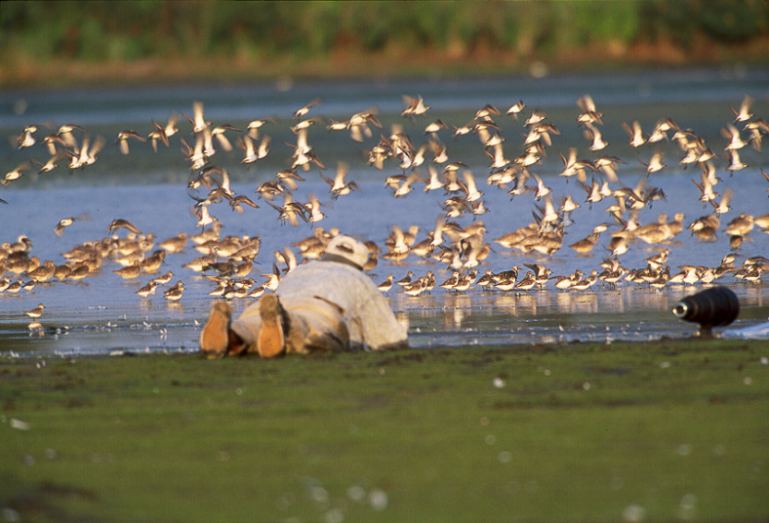 Second lesson: Trust that Arthur will bring you to the best places to shoot!
Second lesson: Trust that Arthur will bring you to the best places to shoot!
We gathered at the edge of the pond to hear Arthurís tips on exposure, bird approach techniques, and shooting etiquette. The latter two were exactly what I Ďd come for, learning the professional practices used by the arguably the most successful bird photographer in the world. These tips alone were worth the price of admission. Iím not going to tell you what these were mind you, as I think you need to attend an IPT to truly learn this material. What I can tell you, and you can probably infer from looking at his The Art of Bird Photography: The Complete Guide to Professional Bird Techniques is that the most beautiful shots of birds (and I would argue people portraiture) are made at the subjectsí eye level. We were here to shoot shorebirds, which are for the most part small, so getting to eye level means getting in the mud!
I had read his Art of Bird Photography before I came on this trip and tried this technique before, so it wasnít quite a shock to me as it was to others. Just imagine how you would feel pulling your $10,000 rig off your $600 tripod/ballhead combo (which was used mostly as hangers for our vests full of stuff we didnít want destroyed) crawling on your belly for 50 yards and planting the foot of your lens in three inches of wet, sloppy, algae covered, stinky black mud. You could tell that some folks would have rather eaten that malodorous stew than lie down in it with their best gear. In fact, some folks opted out of the worming around and shot from their knees and butts. Arthur was only too kind to provide tips for better image making to those not so daring as others.
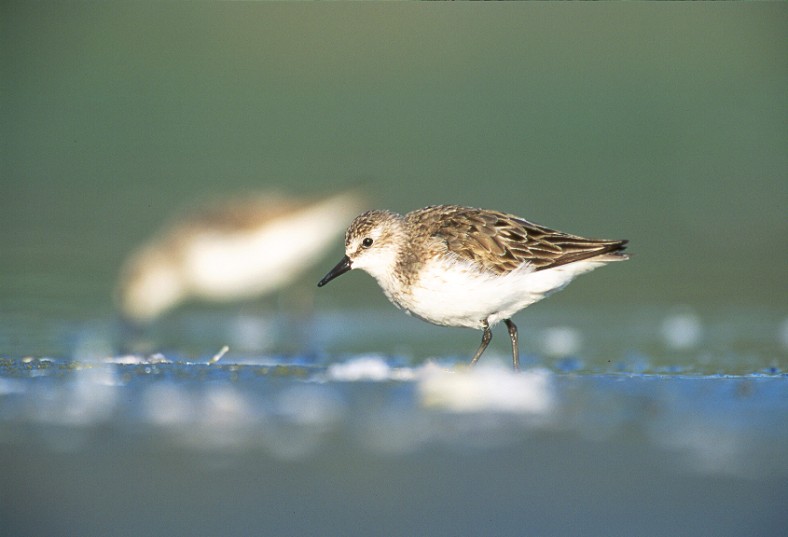 The result of this wackiness (besides being soaked, cold, and rank) was our ability to easily get within 20 feet of these birds, at their level, with the golden sun rising behind us. With my 700mm setup, I got great shots of Semipalmated Plovers and Sandpipers, both 6" (inch) birds. It was a religious experience photographing these creatures on their terms. I managed to burn three rolls on these two species alone, and about two hours after we started, we broke for our second stop.
The result of this wackiness (besides being soaked, cold, and rank) was our ability to easily get within 20 feet of these birds, at their level, with the golden sun rising behind us. With my 700mm setup, I got great shots of Semipalmated Plovers and Sandpipers, both 6" (inch) birds. It was a religious experience photographing these creatures on their terms. I managed to burn three rolls on these two species alone, and about two hours after we started, we broke for our second stop.
Third Lesson: Work to get close, it is the only way to get the best shots.
Second Shoot
The second spot was a bit of a surprise; it was the back porch of a beach house on the bay behind the refuge! From here we shot Snowy and Great Egret, Laughing Gulls, and Common Tern. It was a pleasant break from the muck, and the welcoming homeowner even let us use his bathroom!
Slide Show
Our Intention for the third shoot was to try some macro shooting of flowers and butterflies, but instead we opted for a slide show in the Refuge HQ. The air conditioning and the chance to sit for a while were too powerful to want to shoot macro. At the slide show, we all quickly learned why Arthur is such an incredible bird photographer, he knows birds like no one else Iíve ever met. He knows their biology, their behavior, their plumage schedules, their migration patterns, everything. Arthur exudes enthusiasm for birds and engrosses the audience (which included birders visiting the Refuge as well) with his descriptions of the birds and how he made each image.
This was also a chance to pick up some of Arthurís favorite photo accessories, books, and calendars. I couldnít resist and bought a level, flash extender, and his Shorebirds : Beautiful Beachcombers book.
Fourth Lesson: I you are passionate about your subjects, you have a far greater chance to make beautiful images.
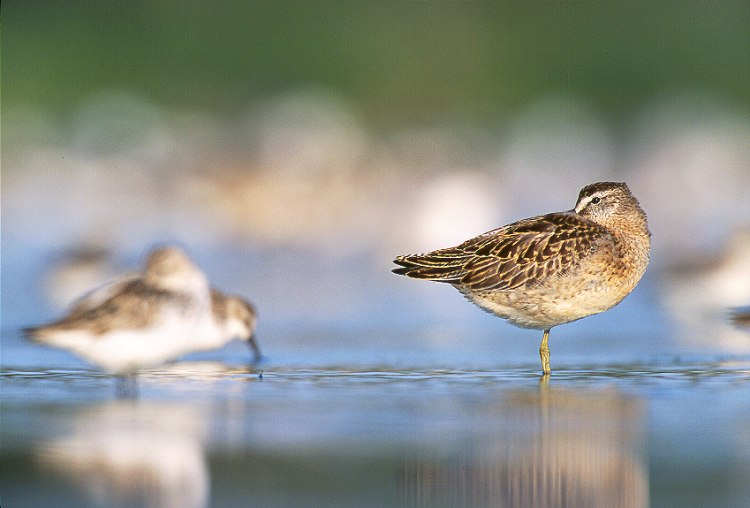 Lunch
Lunch
We broke for lunch a bit later than planned and was treated by Arthur to a nice Chinese food feast at a place called Dannyís, I believe. At lunch Arthur talked about some of his publishing projects and passed around a group of 70mm dupes of some of his best work. If youíve never seen a 70mm dupe, have some made at your favorite lab and have a look on a light table, youíll be duping your best stuff before you know it.
Fifth Lesson: Donít eat so much Chinese when you still have four hours of lugging your camera gear around!
Third Shoot: My Own Time
We had an hour and a half for a break after lunch, and some choose to snooze, wash their clothes, or go on a "health walk" with Arthur. The way Arthur moves around Iím sure this "health walk" was probably more like the mad dash concert-goers make for general admission seats -- not for me thanks. I returned to the West Pond and found most of the same species I had the previous evening plus a new life bird for me, a juvenile Tricolored Heron. I got some good shots of the birds at the rookery, but that was about it since the sun was almost directly overhead.
Fourth Shoot
We returned to the East Pond, this time trekking to the northern most shore. All the same photogs we saw in the morning were here as well and I spent my time tagging along with two of them. Others opted to shoot by themselves, or listen to a few more tips from Arthur. I headed to a small point in the pond that was mobbed with Black Bellied Plover (100+), Lesser Yellowlegs (20-30), Short Billed Dowitchers (10-12), Forsterís Terns (5-6), Least Sandpiper (40-50), Semipalmated Sandpiper (200+), Red Knot (10-12) Marbled Godwit (1), the Swans from last night, Herring Gulls (200+) and Common Tern (200+).

Arthur and one other classmate joined later and together we shot for almost three solid hours. We once again got within petting distance of the birds and made some wonderful shots. I myself ran out of film after going through five rolls. I did not dare to get up to get more film from my vest in fear that I would spook the birds and blow it for the rest of the shooters. After such a long time in this prone position we soon began to develop cramps and aching joints and eventually decided that we would all leave and just get up and walk away, no matter that it would probably cause the entire colony to fly away. We collected our gear, struggled to our feet and anticipated the mass of birds to spray across the pondÖ.but it never happened, the birds were not afraid of us in the least. Amazing.
Sixth Lesson: Expect the unexpected from birds.
Last Shoot
We ran late to the last spot, which was along side the Cross Bay Bridge on the southbound side to catch Cormorants on the pilings in the red sunset swath on the water. It was truly a magical spot with vibrant color on the water. The only problem is that the last Cormorant flew off when we were just getting to the beach. No matter, it was a beautiful scene even without the birds.
Wrap Up
To make a long story even longer, Iíll just say that I learned more at this shoot than I have with most books. In terms of value of the IPT, consider that for the price of a 62mm Heliopan Filter you can learn how to shoot birds with great skill.
This was an invigorating trip for me and freshened my desire to shoot great bird images. Iíve never had more fun with my camera. Iíve never had more fun crawling around in ankle deep muck. I wouldnít hesitate to dive in again.
Arthur is a wonderful instructor, and Iím sure Iíll go on another shoot with him. This time Iíll leave most gear of my gear at home, make sure my pockets are stuffed with film before crawling out to the birds, and bring a pair of waders.
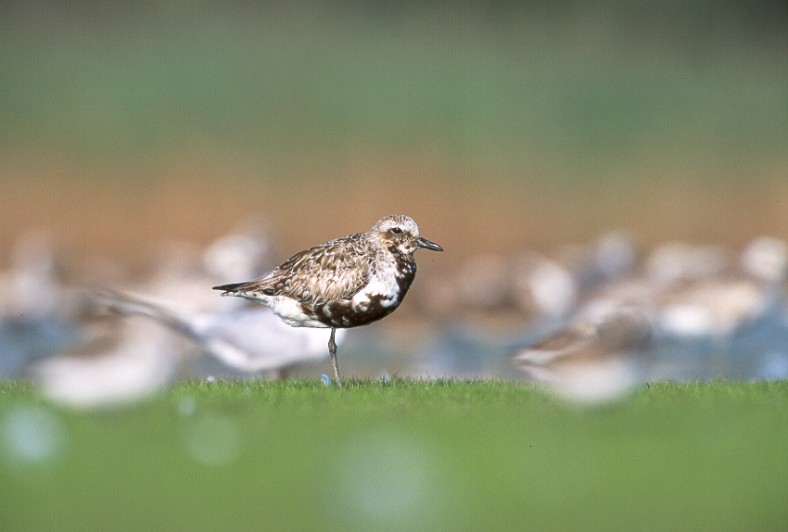
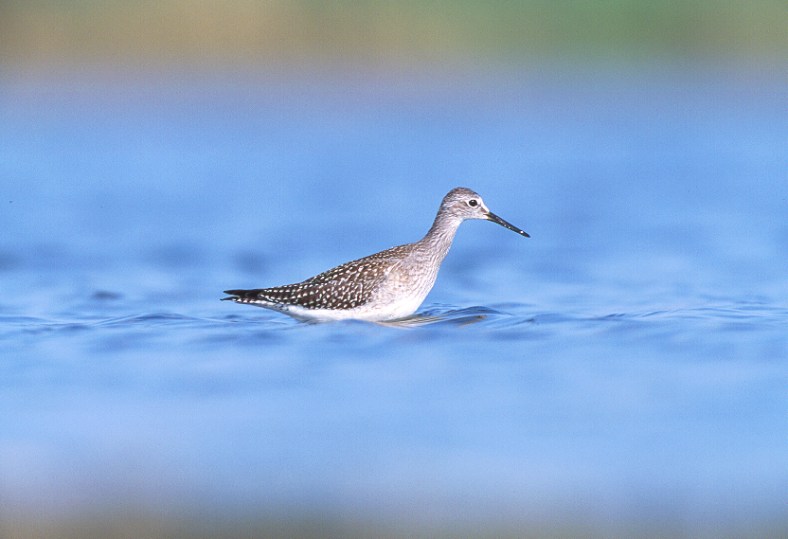
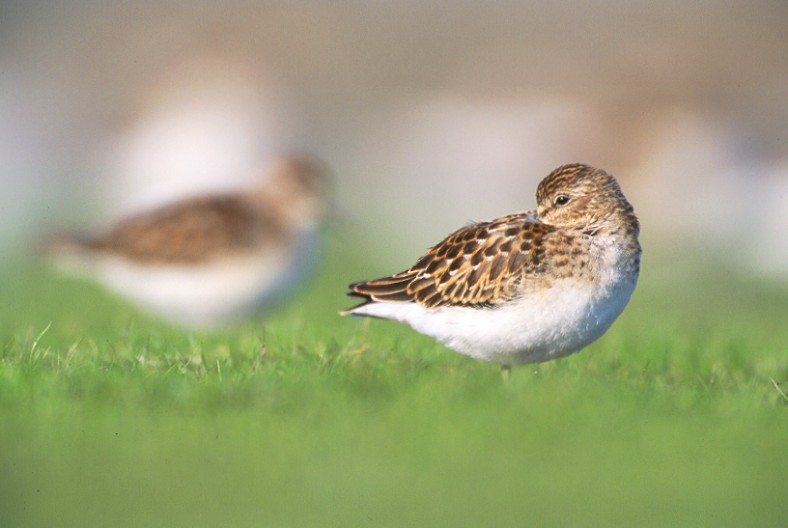
View/Add Comments For This Review
Other books by Arthur Morris:
Bird Photography : Pure and Simple
photo technique / technical reference / the big photography list
kayaking / birding / my book / movie / music picks
home / links / books / tips /images
email: stnoonan@stnphotography.com
 Getting There
Getting There
 I left the West Pond and crossed the street to the East Pond. (Side note: make sure you use the crossing lights if you are going to visit the East Pond as the locals like to use the Cross Bay Blvd as a drag strip!)
I went down the Big Johnís trail and at the last bend before the pond, I was greeted by a Peregrine Falcon not 20 feet above me in a dead tree. This is the best look Iíve had at a Peregrine in the wild, binoculars or not. I figured with the falcon around, there must be a healthy number of birds on this side as well, but alas there were not. This side was very slow, with the exception of 300+ mute swan on the far bank, closest to the train tracks.
I left the West Pond and crossed the street to the East Pond. (Side note: make sure you use the crossing lights if you are going to visit the East Pond as the locals like to use the Cross Bay Blvd as a drag strip!)
I went down the Big Johnís trail and at the last bend before the pond, I was greeted by a Peregrine Falcon not 20 feet above me in a dead tree. This is the best look Iíve had at a Peregrine in the wild, binoculars or not. I figured with the falcon around, there must be a healthy number of birds on this side as well, but alas there were not. This side was very slow, with the exception of 300+ mute swan on the far bank, closest to the train tracks.
 Second lesson: Trust that Arthur will bring you to the best places to shoot!
Second lesson: Trust that Arthur will bring you to the best places to shoot!
 The result of this wackiness (besides being soaked, cold, and rank) was our ability to easily get within 20 feet of these birds, at their level, with the golden sun rising behind us. With my 700mm setup, I got great shots of Semipalmated Plovers and Sandpipers, both 6" (inch) birds. It was a religious experience photographing these creatures on their terms. I managed to burn three rolls on these two species alone, and about two hours after we started, we broke for our second stop.
The result of this wackiness (besides being soaked, cold, and rank) was our ability to easily get within 20 feet of these birds, at their level, with the golden sun rising behind us. With my 700mm setup, I got great shots of Semipalmated Plovers and Sandpipers, both 6" (inch) birds. It was a religious experience photographing these creatures on their terms. I managed to burn three rolls on these two species alone, and about two hours after we started, we broke for our second stop.
 Lunch
Lunch



